Analysis of Toyota RAV4 Models: Pricing, Costs, and Profit Margins
VerifiedAdded on 2023/01/12
|9
|2331
|73
Report
AI Summary
This report provides a comprehensive analysis of the pricing strategies, cost structures, and profit margins of three Toyota RAV4 hybrid models in the Australian market. It examines the current pricing methods, which combine market-oriented and value-based approaches, and analyzes the target costs and profit margins of each model. The report delves into the application of cost-based pricing and market-based pricing strategies, evaluates their advantages and disadvantages, and offers recommendations for maintaining target profit margins through lean manufacturing, value chain analysis, and supply chain optimization. It also explores opportunities to reduce costs, identify value-added and non-value-added activities, and make recommendations regarding the final prices of the product to increase market share and profitability. The report concludes with insights into the mixed pricing strategies employed by Toyota, emphasizing the importance of cost control, supply chain management, and value chain analysis in achieving and sustaining profitability within the competitive automotive market.
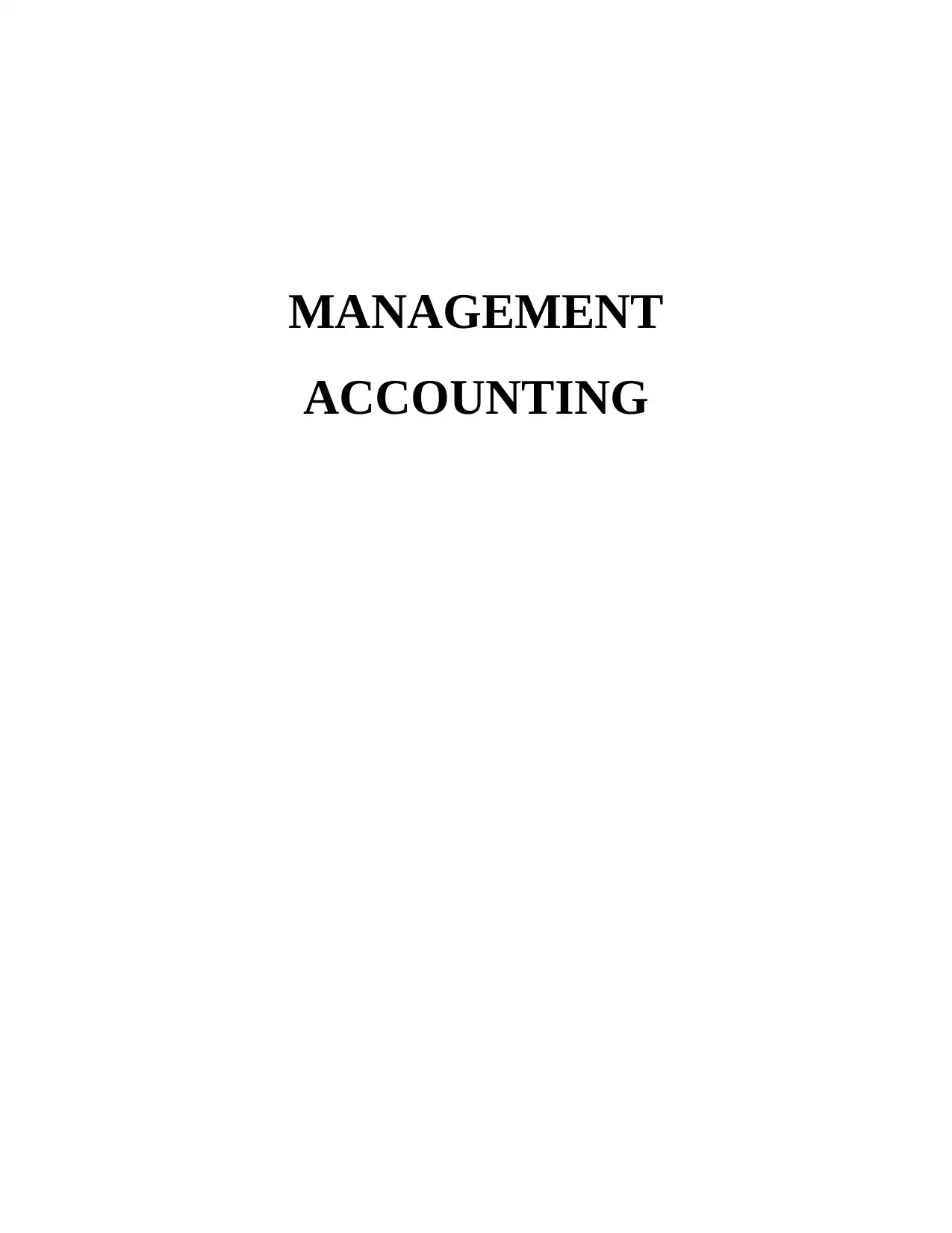
MANAGEMENT
ACCOUNTING
ACCOUNTING
Paraphrase This Document
Need a fresh take? Get an instant paraphrase of this document with our AI Paraphraser
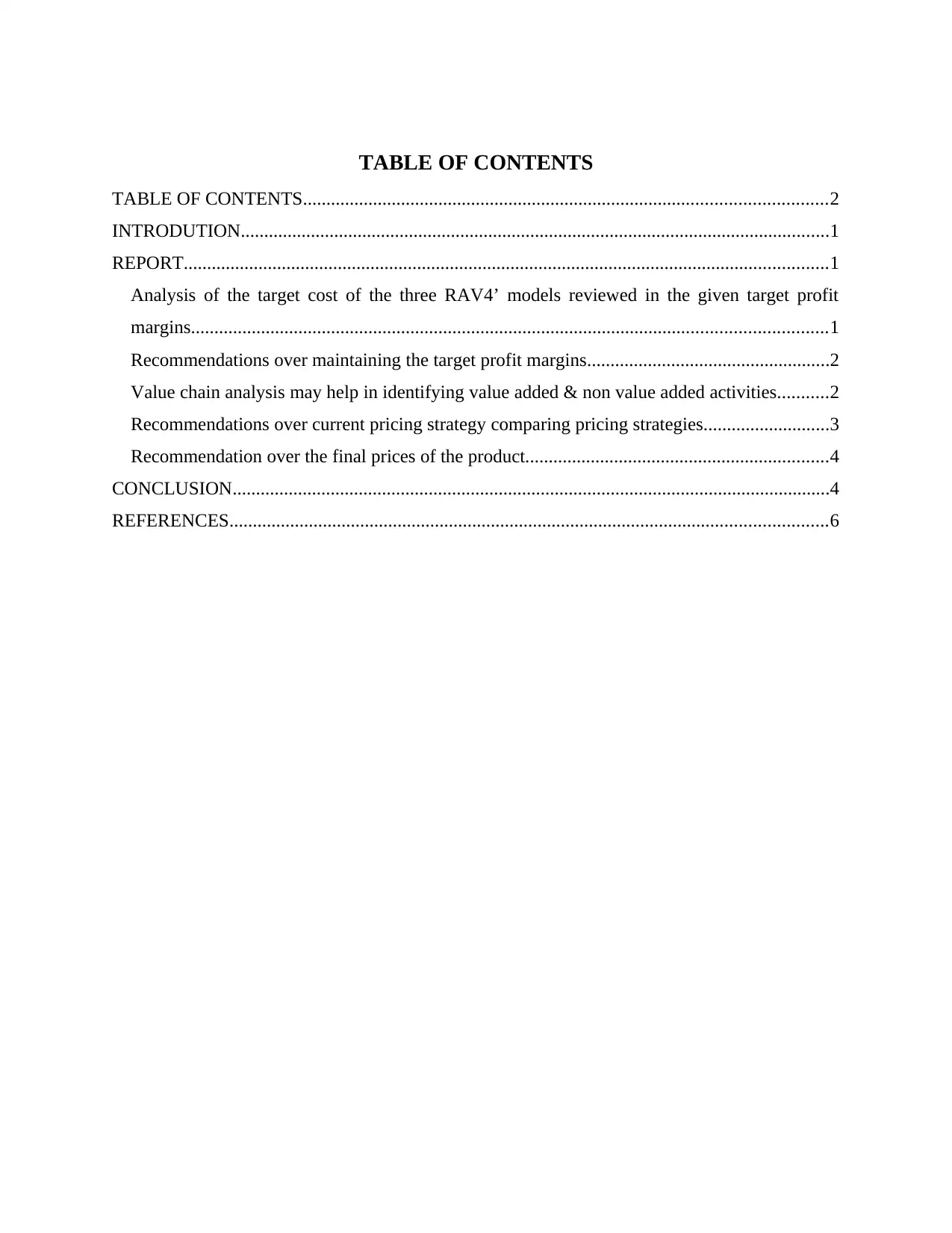
TABLE OF CONTENTS
TABLE OF CONTENTS................................................................................................................2
INTRODUTION..............................................................................................................................1
REPORT..........................................................................................................................................1
Analysis of the target cost of the three RAV4’ models reviewed in the given target profit
margins........................................................................................................................................1
Recommendations over maintaining the target profit margins....................................................2
Value chain analysis may help in identifying value added & non value added activities...........2
Recommendations over current pricing strategy comparing pricing strategies...........................3
Recommendation over the final prices of the product.................................................................4
CONCLUSION................................................................................................................................4
REFERENCES................................................................................................................................6
TABLE OF CONTENTS................................................................................................................2
INTRODUTION..............................................................................................................................1
REPORT..........................................................................................................................................1
Analysis of the target cost of the three RAV4’ models reviewed in the given target profit
margins........................................................................................................................................1
Recommendations over maintaining the target profit margins....................................................2
Value chain analysis may help in identifying value added & non value added activities...........2
Recommendations over current pricing strategy comparing pricing strategies...........................3
Recommendation over the final prices of the product.................................................................4
CONCLUSION................................................................................................................................4
REFERENCES................................................................................................................................6
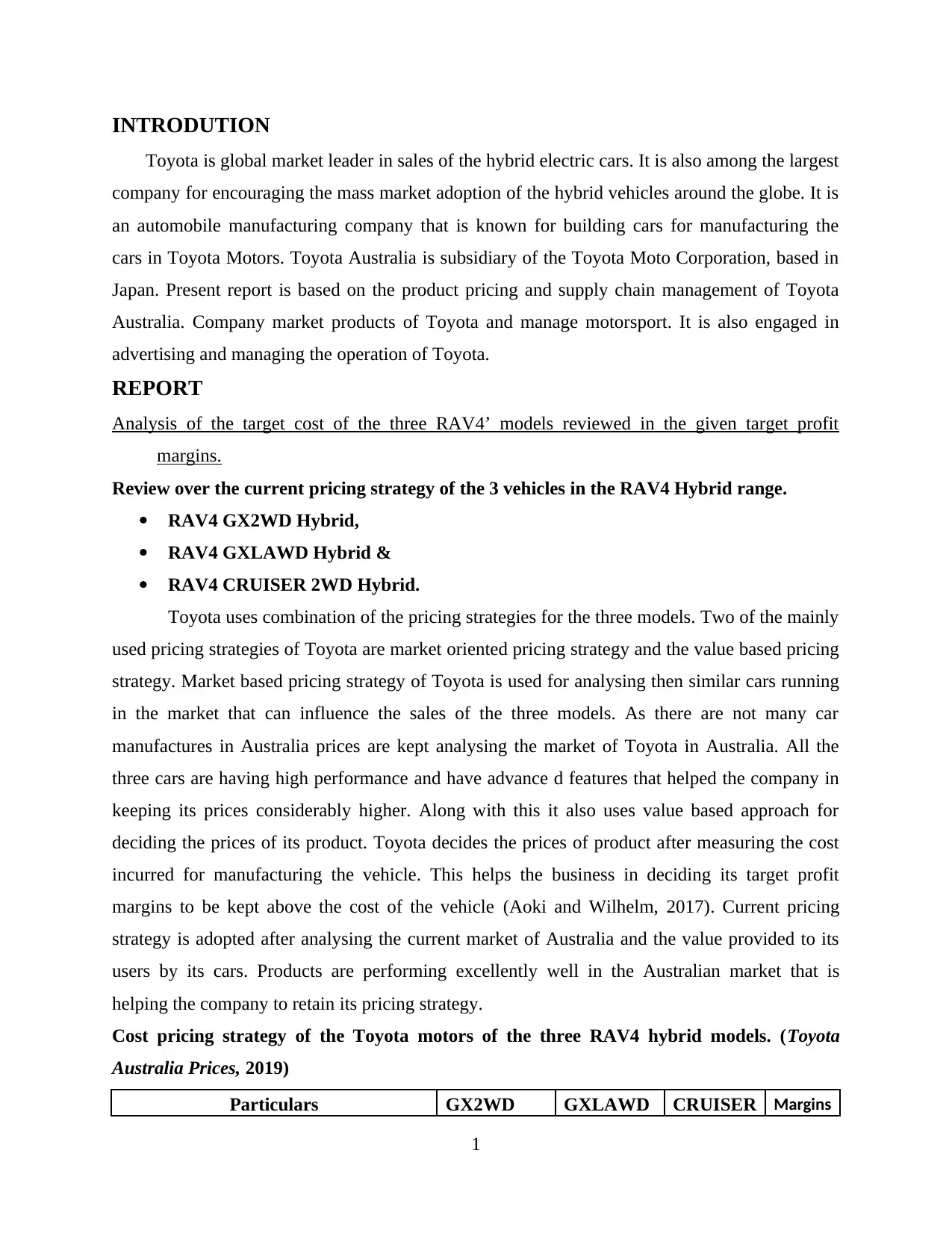
INTRODUTION
Toyota is global market leader in sales of the hybrid electric cars. It is also among the largest
company for encouraging the mass market adoption of the hybrid vehicles around the globe. It is
an automobile manufacturing company that is known for building cars for manufacturing the
cars in Toyota Motors. Toyota Australia is subsidiary of the Toyota Moto Corporation, based in
Japan. Present report is based on the product pricing and supply chain management of Toyota
Australia. Company market products of Toyota and manage motorsport. It is also engaged in
advertising and managing the operation of Toyota.
REPORT
Analysis of the target cost of the three RAV4’ models reviewed in the given target profit
margins.
Review over the current pricing strategy of the 3 vehicles in the RAV4 Hybrid range.
RAV4 GX2WD Hybrid,
RAV4 GXLAWD Hybrid &
RAV4 CRUISER 2WD Hybrid.
Toyota uses combination of the pricing strategies for the three models. Two of the mainly
used pricing strategies of Toyota are market oriented pricing strategy and the value based pricing
strategy. Market based pricing strategy of Toyota is used for analysing then similar cars running
in the market that can influence the sales of the three models. As there are not many car
manufactures in Australia prices are kept analysing the market of Toyota in Australia. All the
three cars are having high performance and have advance d features that helped the company in
keeping its prices considerably higher. Along with this it also uses value based approach for
deciding the prices of its product. Toyota decides the prices of product after measuring the cost
incurred for manufacturing the vehicle. This helps the business in deciding its target profit
margins to be kept above the cost of the vehicle (Aoki and Wilhelm, 2017). Current pricing
strategy is adopted after analysing the current market of Australia and the value provided to its
users by its cars. Products are performing excellently well in the Australian market that is
helping the company to retain its pricing strategy.
Cost pricing strategy of the Toyota motors of the three RAV4 hybrid models. (Toyota
Australia Prices, 2019)
Particulars GX2WD GXLAWD CRUISER Margins
1
Toyota is global market leader in sales of the hybrid electric cars. It is also among the largest
company for encouraging the mass market adoption of the hybrid vehicles around the globe. It is
an automobile manufacturing company that is known for building cars for manufacturing the
cars in Toyota Motors. Toyota Australia is subsidiary of the Toyota Moto Corporation, based in
Japan. Present report is based on the product pricing and supply chain management of Toyota
Australia. Company market products of Toyota and manage motorsport. It is also engaged in
advertising and managing the operation of Toyota.
REPORT
Analysis of the target cost of the three RAV4’ models reviewed in the given target profit
margins.
Review over the current pricing strategy of the 3 vehicles in the RAV4 Hybrid range.
RAV4 GX2WD Hybrid,
RAV4 GXLAWD Hybrid &
RAV4 CRUISER 2WD Hybrid.
Toyota uses combination of the pricing strategies for the three models. Two of the mainly
used pricing strategies of Toyota are market oriented pricing strategy and the value based pricing
strategy. Market based pricing strategy of Toyota is used for analysing then similar cars running
in the market that can influence the sales of the three models. As there are not many car
manufactures in Australia prices are kept analysing the market of Toyota in Australia. All the
three cars are having high performance and have advance d features that helped the company in
keeping its prices considerably higher. Along with this it also uses value based approach for
deciding the prices of its product. Toyota decides the prices of product after measuring the cost
incurred for manufacturing the vehicle. This helps the business in deciding its target profit
margins to be kept above the cost of the vehicle (Aoki and Wilhelm, 2017). Current pricing
strategy is adopted after analysing the current market of Australia and the value provided to its
users by its cars. Products are performing excellently well in the Australian market that is
helping the company to retain its pricing strategy.
Cost pricing strategy of the Toyota motors of the three RAV4 hybrid models. (Toyota
Australia Prices, 2019)
Particulars GX2WD GXLAWD CRUISER Margins
1
⊘ This is a preview!⊘
Do you want full access?
Subscribe today to unlock all pages.

Trusted by 1+ million students worldwide
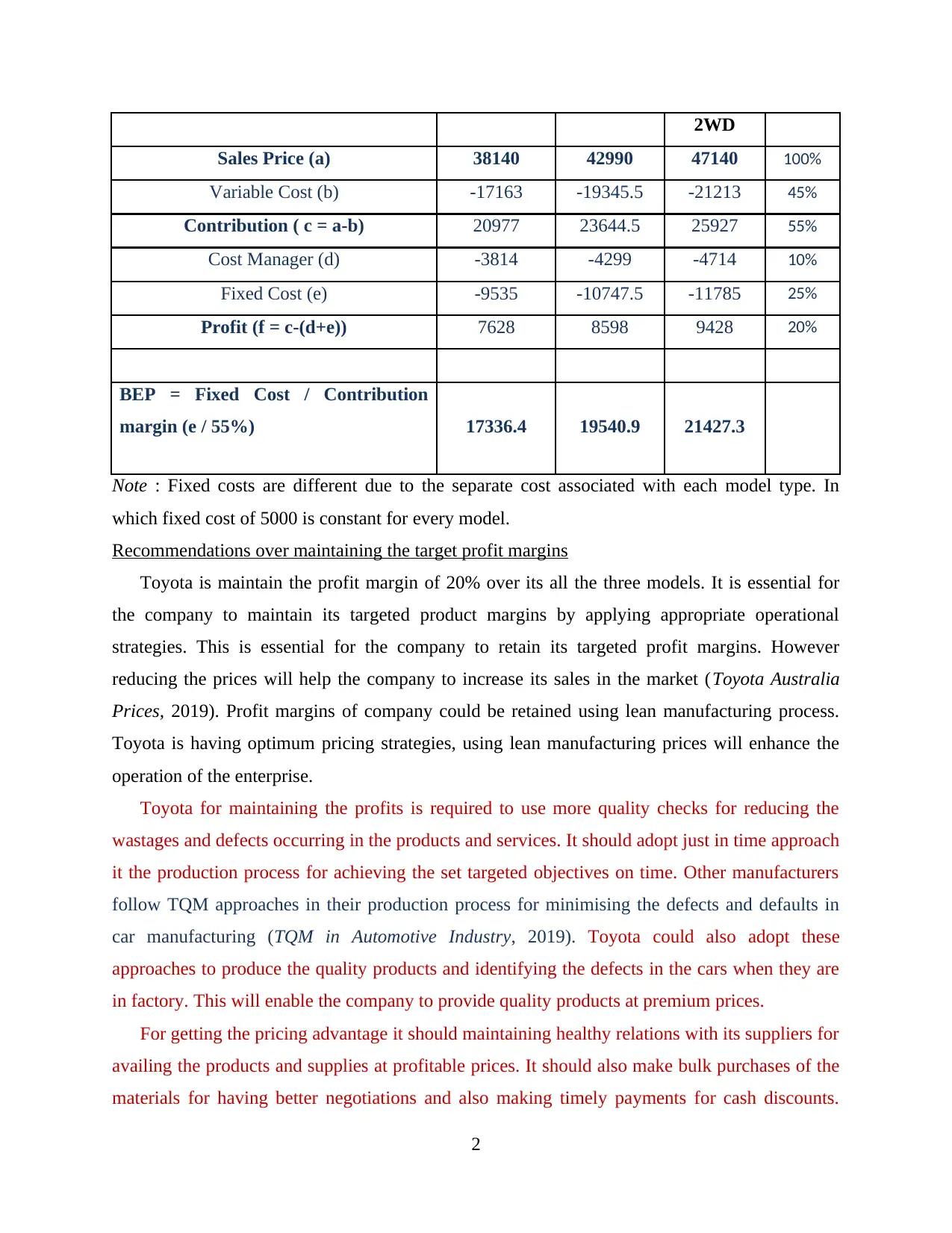
2WD
Sales Price (a) 38140 42990 47140 100%
Variable Cost (b) -17163 -19345.5 -21213 45%
Contribution ( c = a-b) 20977 23644.5 25927 55%
Cost Manager (d) -3814 -4299 -4714 10%
Fixed Cost (e) -9535 -10747.5 -11785 25%
Profit (f = c-(d+e)) 7628 8598 9428 20%
BEP = Fixed Cost / Contribution
margin (e / 55%) 17336.4 19540.9 21427.3
Note : Fixed costs are different due to the separate cost associated with each model type. In
which fixed cost of 5000 is constant for every model.
Recommendations over maintaining the target profit margins
Toyota is maintain the profit margin of 20% over its all the three models. It is essential for
the company to maintain its targeted product margins by applying appropriate operational
strategies. This is essential for the company to retain its targeted profit margins. However
reducing the prices will help the company to increase its sales in the market (Toyota Australia
Prices, 2019). Profit margins of company could be retained using lean manufacturing process.
Toyota is having optimum pricing strategies, using lean manufacturing prices will enhance the
operation of the enterprise.
Toyota for maintaining the profits is required to use more quality checks for reducing the
wastages and defects occurring in the products and services. It should adopt just in time approach
it the production process for achieving the set targeted objectives on time. Other manufacturers
follow TQM approaches in their production process for minimising the defects and defaults in
car manufacturing (TQM in Automotive Industry, 2019). Toyota could also adopt these
approaches to produce the quality products and identifying the defects in the cars when they are
in factory. This will enable the company to provide quality products at premium prices.
For getting the pricing advantage it should maintaining healthy relations with its suppliers for
availing the products and supplies at profitable prices. It should also make bulk purchases of the
materials for having better negotiations and also making timely payments for cash discounts.
2
Sales Price (a) 38140 42990 47140 100%
Variable Cost (b) -17163 -19345.5 -21213 45%
Contribution ( c = a-b) 20977 23644.5 25927 55%
Cost Manager (d) -3814 -4299 -4714 10%
Fixed Cost (e) -9535 -10747.5 -11785 25%
Profit (f = c-(d+e)) 7628 8598 9428 20%
BEP = Fixed Cost / Contribution
margin (e / 55%) 17336.4 19540.9 21427.3
Note : Fixed costs are different due to the separate cost associated with each model type. In
which fixed cost of 5000 is constant for every model.
Recommendations over maintaining the target profit margins
Toyota is maintain the profit margin of 20% over its all the three models. It is essential for
the company to maintain its targeted product margins by applying appropriate operational
strategies. This is essential for the company to retain its targeted profit margins. However
reducing the prices will help the company to increase its sales in the market (Toyota Australia
Prices, 2019). Profit margins of company could be retained using lean manufacturing process.
Toyota is having optimum pricing strategies, using lean manufacturing prices will enhance the
operation of the enterprise.
Toyota for maintaining the profits is required to use more quality checks for reducing the
wastages and defects occurring in the products and services. It should adopt just in time approach
it the production process for achieving the set targeted objectives on time. Other manufacturers
follow TQM approaches in their production process for minimising the defects and defaults in
car manufacturing (TQM in Automotive Industry, 2019). Toyota could also adopt these
approaches to produce the quality products and identifying the defects in the cars when they are
in factory. This will enable the company to provide quality products at premium prices.
For getting the pricing advantage it should maintaining healthy relations with its suppliers for
availing the products and supplies at profitable prices. It should also make bulk purchases of the
materials for having better negotiations and also making timely payments for cash discounts.
2
Paraphrase This Document
Need a fresh take? Get an instant paraphrase of this document with our AI Paraphraser

Also close monitoring will be required over all the production process so that the resources are
utilised efficiently by the enterprise. Keeping the internal costs of the product will enable the
managers to have pricing advantage of the models.
Following recommendation may help in maintaining the target profit margins.
It could be recommended that it should adopt just in time for manufacturing as per the
market demand. This will prevent the carrying cost of company.
Theory of constraints will enable it to identify the operations of business that needs
improvement (Özcan And et.al., 2019). Corrective measures will enable smooth flow of
products to the customers.
It should enhance the TQM process by setting more quality checks for inspecting the
quality of product before entering and before leaving the factory.
Reducing the wastage to the minimum by close monitoring of the resources used in the
production process.
Strategies that are cost efficient should be adopted. It could combine some of the
processes eliminating the separate costs.
Value chain analysis may help in identifying value added & non value added activities.
Supply Chain opportunities for improving the costs.
Supply chain consumes considerable part of the cost of company. Therefore, special focus
is given over reducing the cost incurred in supply chain and having the opportunities for
reducing the costs. Company can establish its plants in locations that are most beneficial for it.
This will reduce various costs of company such as materials and parts transportation costs.
Supply chain should be designed the company that have least costs considering the other factors
that could increase the cost in other ways. Such as establishing in parts that costs high company
to make the products available to the end customers. The available resources of the company
should be used in the best manner by controlling the costs and increasing the productivity.
Value chain analysis helps the business enterprise to identify the activities that are adding
value to their products and non value adding activities that are consuming unnecessary costs of
the products (Chiarini, Baccarani and Mascherpa, 2018). This is essential for the company to
become cost efficient and keep it under control. This provides sustainability to the business and
helps in making cost improvements.
3
utilised efficiently by the enterprise. Keeping the internal costs of the product will enable the
managers to have pricing advantage of the models.
Following recommendation may help in maintaining the target profit margins.
It could be recommended that it should adopt just in time for manufacturing as per the
market demand. This will prevent the carrying cost of company.
Theory of constraints will enable it to identify the operations of business that needs
improvement (Özcan And et.al., 2019). Corrective measures will enable smooth flow of
products to the customers.
It should enhance the TQM process by setting more quality checks for inspecting the
quality of product before entering and before leaving the factory.
Reducing the wastage to the minimum by close monitoring of the resources used in the
production process.
Strategies that are cost efficient should be adopted. It could combine some of the
processes eliminating the separate costs.
Value chain analysis may help in identifying value added & non value added activities.
Supply Chain opportunities for improving the costs.
Supply chain consumes considerable part of the cost of company. Therefore, special focus
is given over reducing the cost incurred in supply chain and having the opportunities for
reducing the costs. Company can establish its plants in locations that are most beneficial for it.
This will reduce various costs of company such as materials and parts transportation costs.
Supply chain should be designed the company that have least costs considering the other factors
that could increase the cost in other ways. Such as establishing in parts that costs high company
to make the products available to the end customers. The available resources of the company
should be used in the best manner by controlling the costs and increasing the productivity.
Value chain analysis helps the business enterprise to identify the activities that are adding
value to their products and non value adding activities that are consuming unnecessary costs of
the products (Chiarini, Baccarani and Mascherpa, 2018). This is essential for the company to
become cost efficient and keep it under control. This provides sustainability to the business and
helps in making cost improvements.
3
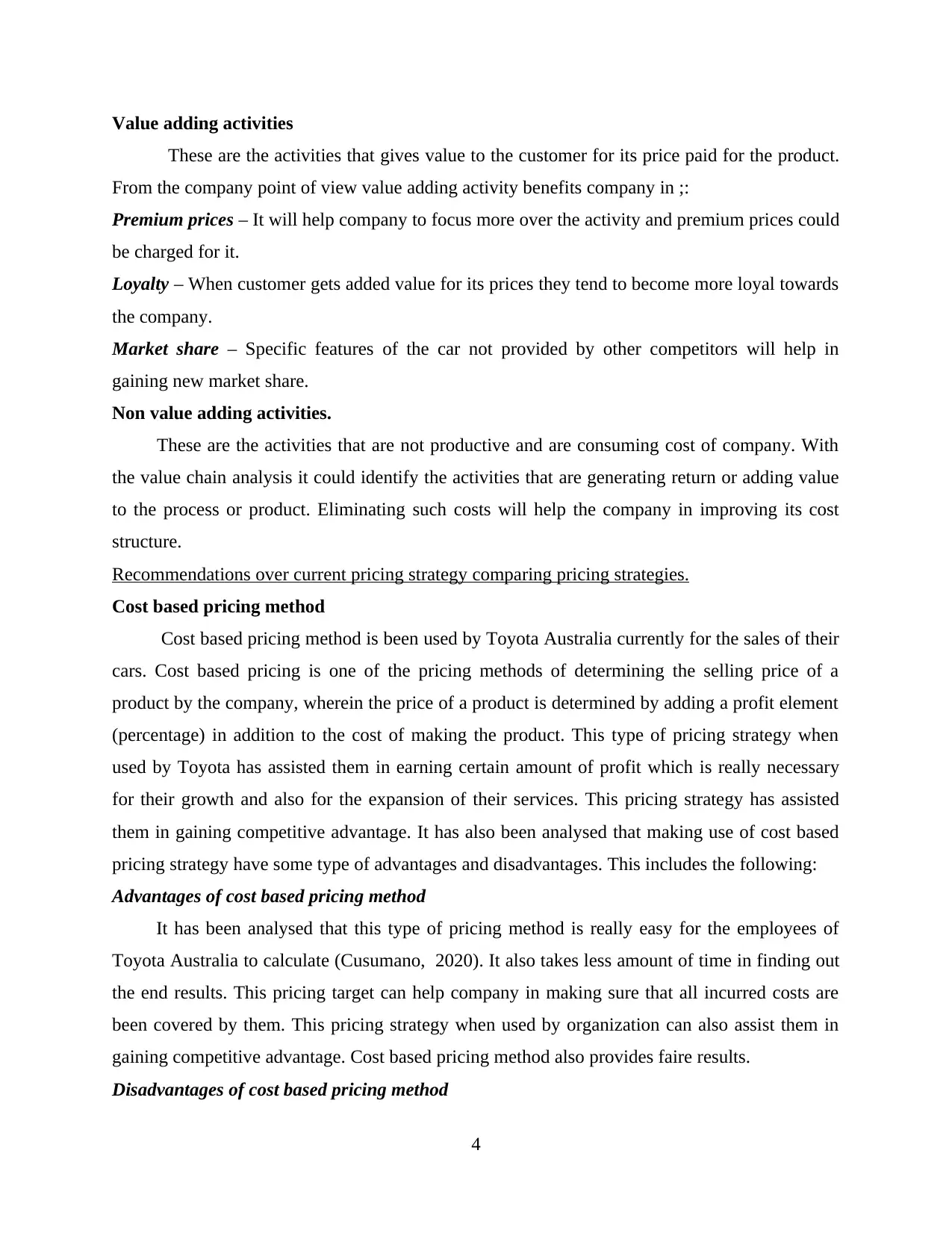
Value adding activities
These are the activities that gives value to the customer for its price paid for the product.
From the company point of view value adding activity benefits company in ;:
Premium prices – It will help company to focus more over the activity and premium prices could
be charged for it.
Loyalty – When customer gets added value for its prices they tend to become more loyal towards
the company.
Market share – Specific features of the car not provided by other competitors will help in
gaining new market share.
Non value adding activities.
These are the activities that are not productive and are consuming cost of company. With
the value chain analysis it could identify the activities that are generating return or adding value
to the process or product. Eliminating such costs will help the company in improving its cost
structure.
Recommendations over current pricing strategy comparing pricing strategies.
Cost based pricing method
Cost based pricing method is been used by Toyota Australia currently for the sales of their
cars. Cost based pricing is one of the pricing methods of determining the selling price of a
product by the company, wherein the price of a product is determined by adding a profit element
(percentage) in addition to the cost of making the product. This type of pricing strategy when
used by Toyota has assisted them in earning certain amount of profit which is really necessary
for their growth and also for the expansion of their services. This pricing strategy has assisted
them in gaining competitive advantage. It has also been analysed that making use of cost based
pricing strategy have some type of advantages and disadvantages. This includes the following:
Advantages of cost based pricing method
It has been analysed that this type of pricing method is really easy for the employees of
Toyota Australia to calculate (Cusumano, 2020). It also takes less amount of time in finding out
the end results. This pricing target can help company in making sure that all incurred costs are
been covered by them. This pricing strategy when used by organization can also assist them in
gaining competitive advantage. Cost based pricing method also provides faire results.
Disadvantages of cost based pricing method
4
These are the activities that gives value to the customer for its price paid for the product.
From the company point of view value adding activity benefits company in ;:
Premium prices – It will help company to focus more over the activity and premium prices could
be charged for it.
Loyalty – When customer gets added value for its prices they tend to become more loyal towards
the company.
Market share – Specific features of the car not provided by other competitors will help in
gaining new market share.
Non value adding activities.
These are the activities that are not productive and are consuming cost of company. With
the value chain analysis it could identify the activities that are generating return or adding value
to the process or product. Eliminating such costs will help the company in improving its cost
structure.
Recommendations over current pricing strategy comparing pricing strategies.
Cost based pricing method
Cost based pricing method is been used by Toyota Australia currently for the sales of their
cars. Cost based pricing is one of the pricing methods of determining the selling price of a
product by the company, wherein the price of a product is determined by adding a profit element
(percentage) in addition to the cost of making the product. This type of pricing strategy when
used by Toyota has assisted them in earning certain amount of profit which is really necessary
for their growth and also for the expansion of their services. This pricing strategy has assisted
them in gaining competitive advantage. It has also been analysed that making use of cost based
pricing strategy have some type of advantages and disadvantages. This includes the following:
Advantages of cost based pricing method
It has been analysed that this type of pricing method is really easy for the employees of
Toyota Australia to calculate (Cusumano, 2020). It also takes less amount of time in finding out
the end results. This pricing target can help company in making sure that all incurred costs are
been covered by them. This pricing strategy when used by organization can also assist them in
gaining competitive advantage. Cost based pricing method also provides faire results.
Disadvantages of cost based pricing method
4
⊘ This is a preview!⊘
Do you want full access?
Subscribe today to unlock all pages.

Trusted by 1+ million students worldwide

This type or pricing strategy is not been useful when Toyota Australia is bringing out some
kind of new and innovative products. This type overpricing method is also inflexible; it cannot
be changed when once used.
Market based pricing strategy
It is also used by Toyota Australia for increasing the sales of their SUV segments in car. In
this type of strategy the price is been set up the company according to the conditions of market
(Monden, 2019). It has been analyse that before going for this type of strategy it is really
necessary for the Toyota Australia to be engaged in doing some sort of market research. This
pricing strategy can assist them in having and sharing a place in market. This will support them
in increasing the value of goods and services which has been sold up by them. It will help the
company in growing and achieving their goals and objectives.
Advantages of market based pricing
This type of pricing strategy assisted Toyota Australia in gaining competitive advantage. It
will assist them in setting their place in market. Market based pricing strategy can help Toyota
Australia in creating consumer loyalty. It will assist them in increasing their market share, profit
as well as loyalty.
Disadvantage of market based pricing method
The main disadvantage of this method is that it does not take into account the pricing
strategy which has been taken by competitors. This can reduce the productivity, production and
sales aspects of Toyota Australia. It can also reduce the number of cars which has been sold up
them. They also do not take in consideration the cost related to production.
Recommendation over the final prices of the product.
Manager should have slight decrease in its prices by controlling the cost of its variable
expenses. In its prices, product comprises of 45% of the variable costs. Using the lean strategies
and value chain activities should reduce the cost of its operations. Slight decrease in prices will
help the company to increase its market share. Reducing the prices will lower the margins of
company but for increasing the market share it can reduce its profit margins by 2% - 3%. This
will also affect the market share of the company being served and hence the existing prices are
favourable for the cmpany.
5
kind of new and innovative products. This type overpricing method is also inflexible; it cannot
be changed when once used.
Market based pricing strategy
It is also used by Toyota Australia for increasing the sales of their SUV segments in car. In
this type of strategy the price is been set up the company according to the conditions of market
(Monden, 2019). It has been analyse that before going for this type of strategy it is really
necessary for the Toyota Australia to be engaged in doing some sort of market research. This
pricing strategy can assist them in having and sharing a place in market. This will support them
in increasing the value of goods and services which has been sold up by them. It will help the
company in growing and achieving their goals and objectives.
Advantages of market based pricing
This type of pricing strategy assisted Toyota Australia in gaining competitive advantage. It
will assist them in setting their place in market. Market based pricing strategy can help Toyota
Australia in creating consumer loyalty. It will assist them in increasing their market share, profit
as well as loyalty.
Disadvantage of market based pricing method
The main disadvantage of this method is that it does not take into account the pricing
strategy which has been taken by competitors. This can reduce the productivity, production and
sales aspects of Toyota Australia. It can also reduce the number of cars which has been sold up
them. They also do not take in consideration the cost related to production.
Recommendation over the final prices of the product.
Manager should have slight decrease in its prices by controlling the cost of its variable
expenses. In its prices, product comprises of 45% of the variable costs. Using the lean strategies
and value chain activities should reduce the cost of its operations. Slight decrease in prices will
help the company to increase its market share. Reducing the prices will lower the margins of
company but for increasing the market share it can reduce its profit margins by 2% - 3%. This
will also affect the market share of the company being served and hence the existing prices are
favourable for the cmpany.
5
Paraphrase This Document
Need a fresh take? Get an instant paraphrase of this document with our AI Paraphraser

CONCLUSION
From the above report it could be concluded that Toyota uses mixed pricing strategies for its
three RAV4 models in Australian market. Pricing strategies are enabling the company to earn the
target profit margin of 20% over its product. With the help of value chain analysis it is promoting
value added activities and eliminating non value adding activities. Supply chain opportunities
help the company in analysing its cost strategies and improving its cost structure.
6
From the above report it could be concluded that Toyota uses mixed pricing strategies for its
three RAV4 models in Australian market. Pricing strategies are enabling the company to earn the
target profit margin of 20% over its product. With the help of value chain analysis it is promoting
value added activities and eliminating non value adding activities. Supply chain opportunities
help the company in analysing its cost strategies and improving its cost structure.
6
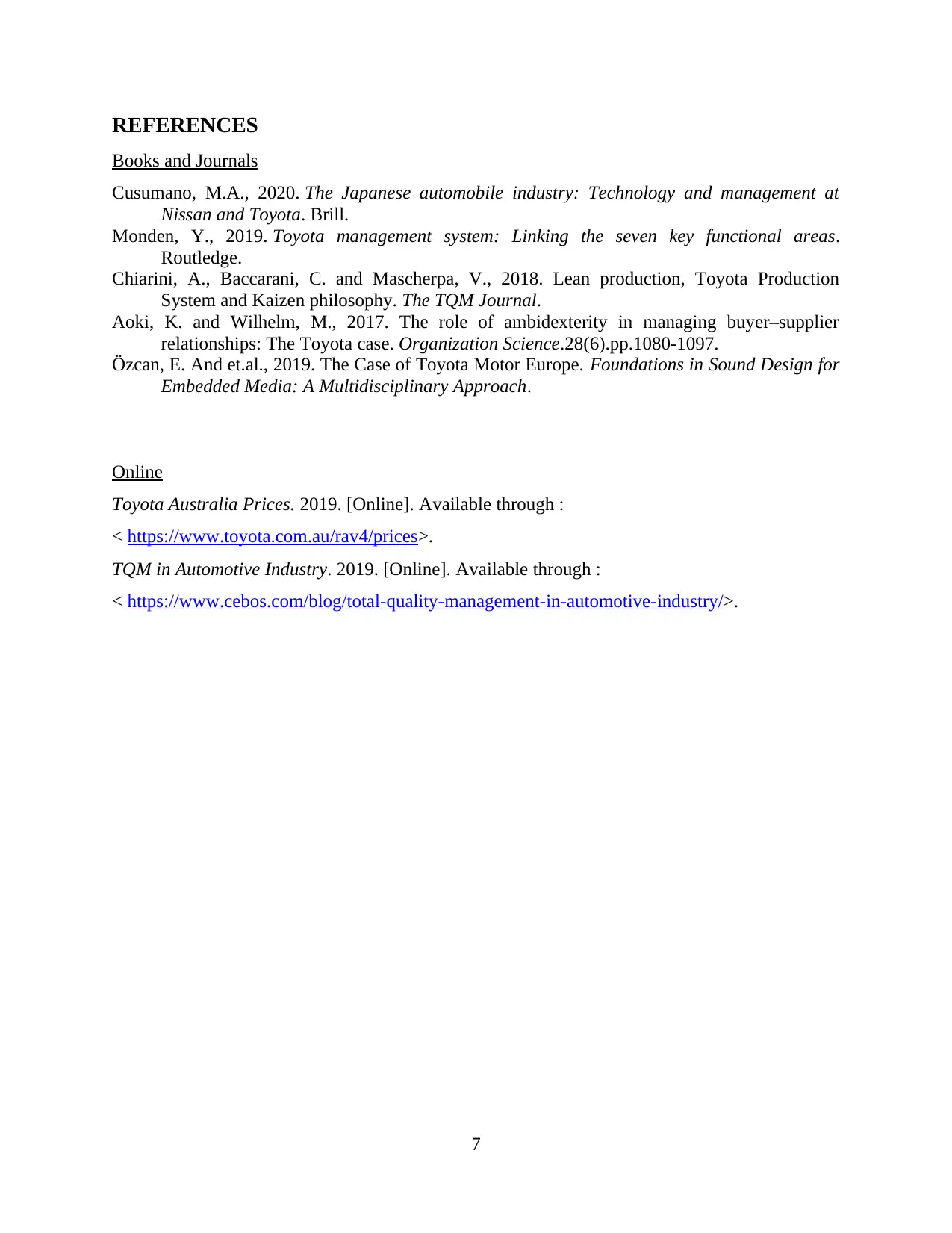
REFERENCES
Books and Journals
Cusumano, M.A., 2020. The Japanese automobile industry: Technology and management at
Nissan and Toyota. Brill.
Monden, Y., 2019. Toyota management system: Linking the seven key functional areas.
Routledge.
Chiarini, A., Baccarani, C. and Mascherpa, V., 2018. Lean production, Toyota Production
System and Kaizen philosophy. The TQM Journal.
Aoki, K. and Wilhelm, M., 2017. The role of ambidexterity in managing buyer–supplier
relationships: The Toyota case. Organization Science.28(6).pp.1080-1097.
Özcan, E. And et.al., 2019. The Case of Toyota Motor Europe. Foundations in Sound Design for
Embedded Media: A Multidisciplinary Approach.
Online
Toyota Australia Prices. 2019. [Online]. Available through :
< https://www.toyota.com.au/rav4/prices>.
TQM in Automotive Industry. 2019. [Online]. Available through :
< https://www.cebos.com/blog/total-quality-management-in-automotive-industry/>.
7
Books and Journals
Cusumano, M.A., 2020. The Japanese automobile industry: Technology and management at
Nissan and Toyota. Brill.
Monden, Y., 2019. Toyota management system: Linking the seven key functional areas.
Routledge.
Chiarini, A., Baccarani, C. and Mascherpa, V., 2018. Lean production, Toyota Production
System and Kaizen philosophy. The TQM Journal.
Aoki, K. and Wilhelm, M., 2017. The role of ambidexterity in managing buyer–supplier
relationships: The Toyota case. Organization Science.28(6).pp.1080-1097.
Özcan, E. And et.al., 2019. The Case of Toyota Motor Europe. Foundations in Sound Design for
Embedded Media: A Multidisciplinary Approach.
Online
Toyota Australia Prices. 2019. [Online]. Available through :
< https://www.toyota.com.au/rav4/prices>.
TQM in Automotive Industry. 2019. [Online]. Available through :
< https://www.cebos.com/blog/total-quality-management-in-automotive-industry/>.
7
⊘ This is a preview!⊘
Do you want full access?
Subscribe today to unlock all pages.

Trusted by 1+ million students worldwide
1 out of 9
Related Documents
Your All-in-One AI-Powered Toolkit for Academic Success.
+13062052269
info@desklib.com
Available 24*7 on WhatsApp / Email
![[object Object]](/_next/static/media/star-bottom.7253800d.svg)
Unlock your academic potential
Copyright © 2020–2025 A2Z Services. All Rights Reserved. Developed and managed by ZUCOL.




